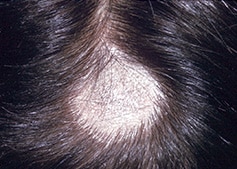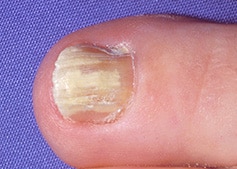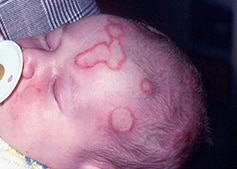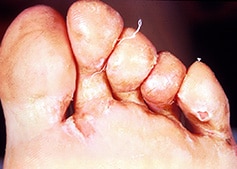PDF 146 KB
Fungal infections are superficial infections of the skin, hair or nails caused by a variety of fungi - includes ringworm, tinea, athlete’s foot fact sheet
Fungal infections are commonly called 'ringworm' but are not caused by worms. They are superficial infections of the skin, hair or nails caused by a variety of fungi which otherwise live in the soil, on animals, or sometimes only on people.
Infections are spread by direct skin contact (with humans or animals), or indirectly from contaminated articles on floors or in the soil. Shared changing rooms and showers are often a source of tinea, while some infections are spread by sharing of items such as towels. People shed tiny pieces of skin all the time and if these contain a small amount of the fungus, it is able to survive in the environment and cause infection in someone else.
Often these infections are localised to specific parts of the body:
Begins as a small pimple which spreads outwards, leaving a scaly hairless patch. Infected hairs become brittle and break off easily (see image).

Usually involves one or more nails of the hands and feet, most often the feet. The nail gradually thickens, becomes discoloured (white or yellowish) and brittle. Cheesy material forms beneath the nail or the nail becomes chalky and disintegrates (see image).

(other than scalp, bearded areas and feet)
Appears as a flat, spreading ring-shaped lesion. The edge is usually reddened and may be dry and scaly or moist and crusted. The centre of the patch may appear to be normal skin (see image).

Appears as scaling or cracking of the skin, especially between the toes. It is often very itchy (see image).

Diagnosis is usually made following examination of the skin by a doctor, and examining small samples of skin, hair or nail under the microscope, then by growing the fungus from the sample. Knowing which fungus is causing the infection gives information on what treatments are best and how to prevent new infections occurring. For example, if the cause is a fungus which normally lives on animals, it may be necessary to treat pets in the household. Sometimes a dog or cat can have a fungal infection which causes only mild symptoms in the animal, but is much more irritating in people. It is also possible for pets to get infections from their owners.
(time between becoming infected and developing symptoms)
Varies with site of infection and the particular fungus.
(time during which an infected person can infect others)
As long as the condition persists untreated. Some treatments will rapidly kill the fungus and prevent spread to others.
Specific antifungal therapies (directly applied to the skin and/or taken by mouth) are available for both humans and animals. Sometimes the treatment must be continued for many months.
These fungal infections can be prevented by the following measures:
All images courtesy A/Prof. David Ellis, Women’s and Children’s Hospital, Adelaide, South Australia